Process for preparing a silicon/carbon composite material, material thus prepared and electrode notably negative electrode comprising this material
a composite material and material technology, applied in the field of process for preparing a silicon/carbon composite material, can solve the problems of low reversible capability, irreversible capacity loss, and limited performance of current materials, in particular active materials for electrodes
- Summary
- Abstract
- Description
- Claims
- Application Information
AI Technical Summary
Benefits of technology
Problems solved by technology
Method used
Image
Examples
example 1
[0151]In this example, a composite silicon / carbon material is prepared according to the process of the invention.
[0152]Under stirring, polystyrene (PS) is placed in solution in 2-butanone, at concentrations ranging from 200 g / litre of solvent to 10 g / litre of solvent. The preferred solution is 60 g / litre.
[0153]Each time, it must be waited until the polystyrene is fully dissolved in the solvent, and a solution of polystyrene in 2-butanone is therefore obtained.
[0154]In each of the polystyrene solutions, silicon is added in powder form with a nanoparticle size of less than 100 nm, supplied by Aldrich®, and the mixture is homogenized by ultrasounds under magnetic stirring. In this manner, dispersions of silicon particles in the polystyrene solutions are obtained, for example a dispersion of 60 g PS per litre of solvent and 3 g of Si per litre of solvent.
[0155]Each of these dispersions is then added to a spray-drying device, namely a > apparatus obtained from Buchi®. Each of the dispers...
example 2
[0175]In this example, the electrode active material comprises a composite Si / C material prepared according to Example 1 above, by pyrolysis of a Si / PS composite (FIG. 4) at a temperature of 900° C.
[0176]A test is conducted following a first cycling procedure:[0177]20 C / 10 charging-discharging cycles (charging in 10 hours, discharging in 10 hours),[0178]10 C / 5 charging-discharging cycles,[0179]5 C / 2 charging-discharging cycles,[0180]5 cycles at C,[0181]5 cycles at 2C,[0182]5 C / 5 discharging-charging cycles.
[0183]The results of this test are illustrated in FIG. 7.
[0184]It is ascertained that at 20° C., under C / 10 test conditions (C equivalent to 1300 mAh / g), this system delivers a stable capacity of about 1700 mAh / g (FIG. 6).
[0185]After successive C / 5, C / 2, C, 2C cycling operations, the system recovers a capacity of the order of 1000 mAh / g.
example 3
[0186]In this example, a battery comprising the same active electrode material as in Example 2, is subjected to a test following a second cycling procedure comprising 35 discharging-charging cycles at C / 2.5. It is ascertained that the capacity is in the region of 800 mAh / g with a very low drop in capacity, as is illustrated in FIG. 7.
PUM
| Property | Measurement | Unit |
|---|---|---|
| concentration | aaaaa | aaaaa |
| concentration | aaaaa | aaaaa |
| diameter | aaaaa | aaaaa |
Abstract
Description
Claims
Application Information
 Login to View More
Login to View More - R&D
- Intellectual Property
- Life Sciences
- Materials
- Tech Scout
- Unparalleled Data Quality
- Higher Quality Content
- 60% Fewer Hallucinations
Browse by: Latest US Patents, China's latest patents, Technical Efficacy Thesaurus, Application Domain, Technology Topic, Popular Technical Reports.
© 2025 PatSnap. All rights reserved.Legal|Privacy policy|Modern Slavery Act Transparency Statement|Sitemap|About US| Contact US: help@patsnap.com



